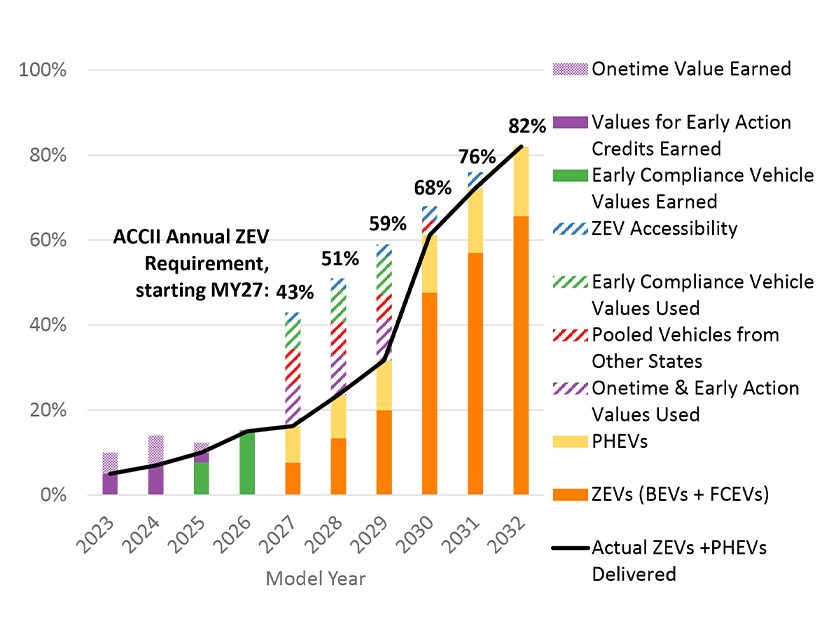
New Mexico regulators adopted zero-emission requirements for cars and trucks in a move that proponents say will improve air quality, fight climate change and increase consumers’ choice of vehicles.
New Mexico regulators on Nov. 16 adopted zero-emission requirements for cars and trucks, a move that proponents say will improve air quality, fight climate change and increase consumers’ choice of vehicles.
The state Environmental Improvement Board (EIB) voted to adopt California’s Advanced Clean Cars II rules — but with a twist. In California, ACC II will increase manufacturers’ supply of zero-emission cars each year through 2035, when the sale of gas-powered cars will be banned with the exception of a limited number of plug-in hybrids. (See California Adopts Rule Banning Gas-powered Car Sales in 2035.)
In contrast, New Mexico has opted to follow ACC II through 2032, when 82% of cars that manufacturers deliver for sale must be zero-emission. Colorado took a similar approach: The state’s Air Quality Control Commission last month adopted ACC II with a maximum ZEV requirement of 82% in 2032.
Clean Cars, Trucks
In New Mexico, the EIB also voted Nov. 16 to adopt California’s Advanced Clean Trucks (ACT), a rule that requires an increasing percentage of medium- and heavy-duty trucks sold in the state to be zero-emission. ACC II and ACT in New Mexico will begin with vehicle model year 2027.
The rules package also includes more stringent emission standards for internal combustion vehicles. The package was adopted during a joint hearing of the EIB and the Albuquerque-Bernalillo County Air Quality Control Board, which governs air quality within Bernalillo County.
Following the board votes, the New Mexico Environment Department (NMED) said the rules package “will significantly increase consumer choice for New Mexicans by assuring new and used zero-emission vehicles are available for lease or purchase.”
The rules also reflect New Mexico Gov. Michelle Lujan Grisham’s commitment to a “cleaner, greener future,” NMED said. Lujan Grisham (D) announced in July that the state would enact the clean cars and trucks rules.
Adoption of the rules was welcomed by a coalition of climate, environmental justice and business groups known as New Mexico Clean Air.
“New Mexicans will be able to breathe easier, buy more clean, affordable vehicles and help put the brakes on climate change with the adoption of Clean Cars and Trucks Standards,” Alexis Mena, New Mexico policy director at the Natural Resources Defense Council, said in a statement.
Opponents said the California rules are a poor fit for New Mexico.
Nicholas Maxwell, a resident of rural Lea County, said New Mexico’s path must account for “the vast rural spaces and the spirit of independence that define us.”
“The economic impact of these proposed standards shouldn’t be underestimated,” Maxwell told the EIB. “We should avoid speeding toward a future that our current infrastructure and economy are not ready to support.”
Keeping Up with California
The federal Clean Air Act allows California to adopt its own vehicle emission standards if they are at least as stringent as the federal standards. The state must receive an EPA waiver before it can enforce its own emission rules.
Other states may adopt California’s rules or stick with the federal emission standards.
New Mexico adopted ACC II’s predecessor, Advanced Clean Cars, in May 2022. (See NM Adopts Calif. Advanced Clean Cars Rules.) Just a few months later, in August 2022, California updated its rules with the adoption of ACC II.
As a result, New Mexico no longer will be able to enforce the first version of Advanced Clean Cars after California receives an EPA waiver for ACC II, according to Claudia Borchert, NMED’s climate change bureau chief.
“Without these amendments, these rules as they exist today will be unenforceable — once EPA as anticipated grants a waiver for ACC II,” Borchert said during the EIB hearing.
Under ACC II, automakers face a steep jump to deliver 43% ZEVs for sale in model year 2027.
But Borchert said manufacturers have a number of ways to earn credits and reduce the actual number of ZEVs they must deliver in a particular year.
They may apply early action credits earned from ZEVs supplied before model year 2027. Up to 20% of the ZEV requirement may be met with plug-in hybrid electric vehicles (PHEVs). Credits may be bought or sold from other automakers or banked for later.
And manufacturers may help fill a deficit in one state with credits from oversupplying ZEVs in another ACC II state.
In addition, extra credits may be earned by selling previously leased ZEVs through a financial assistance program, providing new ZEVs at a discount to community-based clean mobility programs or delivering less expensive new ZEVs or PHEVs. For the latter, the extra credit is available for zero-emission cars with a manufacturer’s suggested retail price of $20,250 or less and light trucks with an MSRP of $26,670 or less.
If manufacturers take full advantage of the various credits, the minimum ZEV delivery requirements drop to as low as 8% in model year 2027, Borchert said in written testimony.
“That 8% target for the first model year of compliance is not much greater than New Mexico’s projected 2023 market share of BEVs of 4.5%,” Borchert said.
